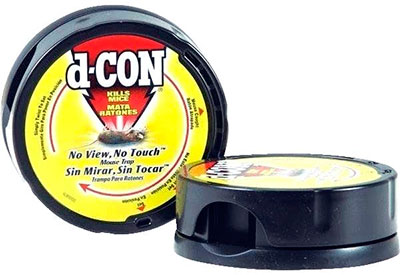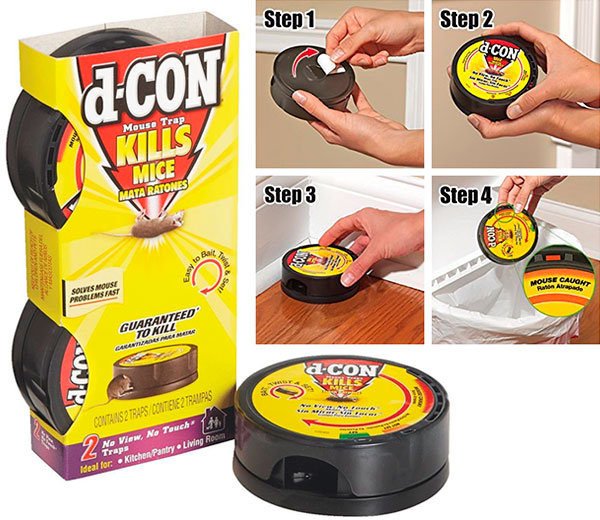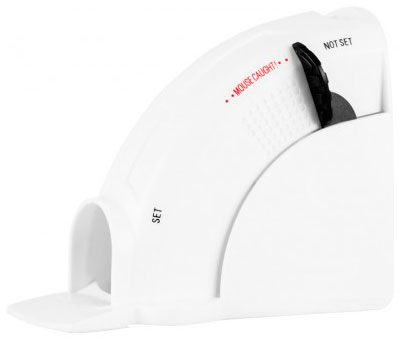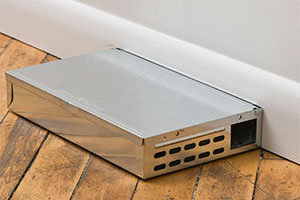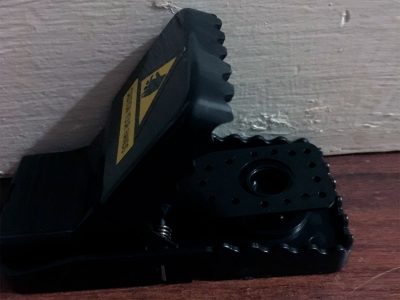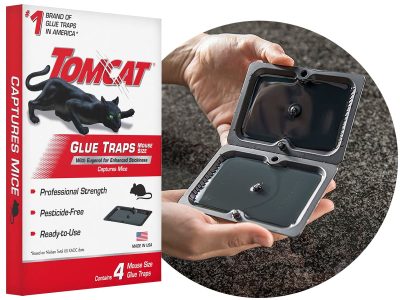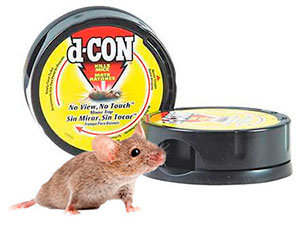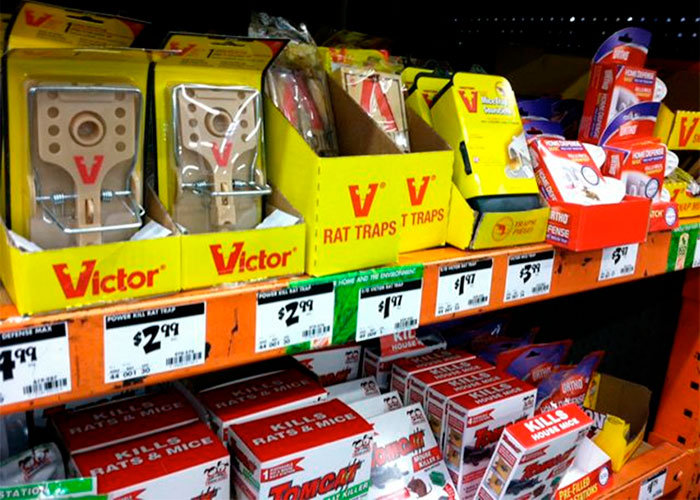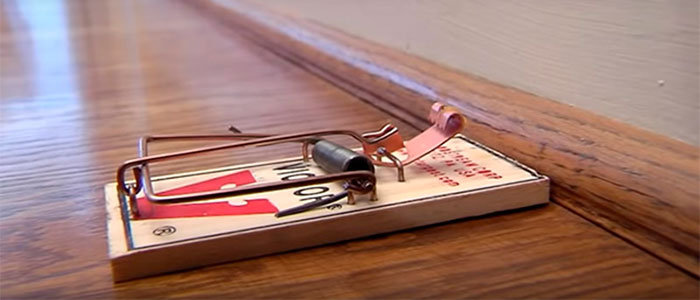
- LAST UPDATED: December 4, 2023
Are you looking for an effective way of eliminating mice and the best trap to use? After much research, some products stand out more than others. And the winner is Victor M2524 Black Box Electronic Mouse Trap.
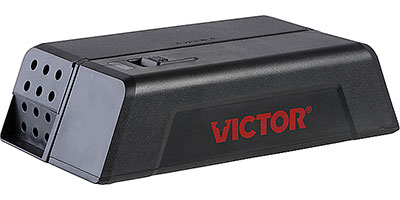
Here I suggest the best products with different brands for your consideration. If you require additional information, look at the links next to each product’s title.
Our Recommended Top 5 Best Mouse Traps Comparison Table
| PREVIEW | PRODUCT | |
|---|---|---|
Our #1 Rated  | Victor M250S Black Box Electronic Mouse Trap
| Check Price |
Best Budget  | Victor M156 Pedal Mouse Trap
| Check Price |
 | d-CON Covered Mouse Trap
| Check Price |
 | Tomcat Kill and Contain Mouse Trap
| Check Price |
 | Victor M310S TIN CAT Humane Live Mouse Trap
| Check Price |
In this article, I will review some of the best mouse traps available on the market.
This review only covers the most popular mouse traps currently on sale. Many types of mouse traps are available to the consumer, and I have only reviewed what is most popular.
I hope you find this article helpful when deciding which option will work best for your situation, whether it’s a home or business environment that needs dealing with. There are many factors involved in choosing just one single trap from all those currently on sale to consumers right now, so please read through my review carefully as there may be one model more suitable than another depending on the size of mouse infestation problem you face at home or office building where mice reside/have been spotted inside premises.
5 Best Mouse Traps Reviewed
Here is a run-down of our 5 top mouse traps picks for the following five categories:
- No-touch, no-view. After all, who wants to see a dead mouse or get one’s fingers all over it?
- Electrocution. An innovative, humane, and very effective way to rid yourself of rodents.
- Safety and ease of use. Simplicity and safety should always be number one priorities!
- Disposable/reusable. Want the choice of a simple throw-away versus a use-again model? Of course. Who doesn’t?
- Affordable. When you have to de-mouse a whole house, the price tag does start to matter.
That’s a basic introduction, but here are the details of which mousetrap wins in each category and how to use it:
1. Victor M250S Black Box – Best Electric Trap to Catch a Mouse
You can’t do better than Victor if you want the best electric mouse trap, but don’t want to build it yourself.
It runs on 4 AA batteries, not on an outlet and plug, so you can place it anywhere that mice might likely find it. It uses a “smart circuit” to detect when a mouse ventures inside the “black box of death.”
The Victor Electronic Mouse Trap comes with an auto-safety switch to protect kids and pets who already can’t get inside to activate the trap anyway. And its interior design prevents mice from getting out during the 5-seconds max they have to live after the initial shock.
If we were asking what’s the most fun mousetrap to use, I’d say it was found in an old Mouse Trap game.
But as to the best overall mouse trap for catching mice, my personal favorite is the Victor Black Box Electronic Trap, for the following excellent reasons:
- Mechanical failure or missing the mouse or the right part of the mouse are never an issue. Zap and dead. That’s it.
- Victor M250S electric traps are small enough that you can place them anywhere.
- The batteries last long since it only takes a little power per zap. So, electronic traps can kill a lot of mice before you even have to change their batteries.
- There’s no mess, and the mouse is inside, so you don’t see it till you dump it out and then put the trap back in position.
How to Use
The Victor electronic mouse trap is a humane way of killing mice that is also safe around children and pets because it uses electricity instead of poison or traps. This product has four AA batteries, which can kill up to 50 mice before needing new ones! It features an indicator light that will let you know when your best electric mouse trap requires more power. But this product may never need more power since it works quickly and efficiently!
Finally, the best part about these electronic traps is how easy they are to clean. No blood or mess is left behind, so you can quickly dispose of the mouse without hassle.
- Humane way to get rid of mice.
- Safe around children and pets.
- No more worrying about the mess left behind by a mouse trap!
- Electric traps are expensive.
- It may take too long for the mouse to die.
2. Victor M156 – Best Budget Traditional Mouse Traps
For those looking for a very cheap but still effective (old school style) best classic mouse trap, Victor is our pick for the best in this category.
The Victor M156, specifically, is easier to set without accidentally setting it off than many of its competitors. Yet, it’s sensitive enough that mice have difficulty stealing the bait.
How Does It Work
This best classic mouse trap has many benefits, making it an excellent choice for trapping mice. It’s easy to set – use your thumb! This mouse killer trap is perfect for indoor or outdoor use in sheds, outbuildings, garages, or barns, as well as on farms or commercial premises. The self-setting trap has a hairbreadth sensitivity which means as soon as the mouse steps on it, and it will trigger and catch/kill the rodent.
The traditional American-made wood mouse killer is ideal for those who prefer buying locally produced goods like this reusable kill trap.
- Reusable – once you’ve caught a mouse, it’s ready to be used again.
- Made in the USA.
- The hairbreadth sensitivity doesn’t always work for this trap, meaning it will sometimes not catch mice.
- Difficult to reset mouse trap.
How to Use
Here’s how to use a Victor Easy Set Mouse trap properly:
Remove the clip that secures the kill bar to the rest of the trip. The clip should be easy to locate when looking at the top part of the trap with the Victor logo.
- Position the armbar so it hangs over the trap’s back. Leverage is essential for the arm bar to work properly when trapping a mouse.
- Bait the trap properly using rodent pellets. You can also use protein-rich foods that attract mice, like peanut butter. Ensure the bait is placed on the yellow portion of the trap where it will be most effective.
- Pull the kill bar back with your thumb, careful not to close it quickly. Keep pressure on the bar during this process, so it doesn’t snap back quickly.
- Position the arm bar over the kill bar. Latch this under the yellow portion of the trap holding the bait. Set the trap to the side marked ‘sensitive’ to kill mice more effectively.
- Place the trap directly against the wall wherever you feel you have activity. Areas where you have seen mouse droppings or tracks are ideal.
- Place traps around your home as necessary. Once mice have been trapped, dispose of each mouse and reset following the same directions.
3. d-CON Covered – Best No View, No Touch Mouse Snap Traps
For a simple way to kill mice without having to really “deal with” them, d-CON takes first place. These covered snap traps hide rodents from view, kill them with humanely sudden death, and leave no mess to clean up.
It’s also safer around children and pets because you don’t have to deal with the dead mouse yourself. These snap traps are perfect for kitchens, bathrooms, bedrooms, pantries, or living rooms.
- Conceals the dead mouse from view.
- Saves time by eliminating messy cleanup – dispose of the entire trap!
- Ideal to discreetly kill the mice in areas where you don’t want them to be seen.
How to use
Just peel back the label, put some mouse trap bait inside, and wind the trap up counterclockwise till you hear it click. When you see the red fill up the “set” hole on the trap’s top, it’s set.
Just throw d-CON disposable traps away from the entire, with a dead rodent after successful use. They work best with smaller mice.
- Step 1. Peel Back Self-Adhesive Label, Insert Bait & Reseal.
- Step 2. Twist & Set Trap.
- Step 3. Place Snap Traps In High Traffic Mouse Area.
- Step 4. Dispose Of Trap When Red Indicator Says ‘Mouse Caught.’
- Discreet cover conceals captured mice from view, saving time and hassle.
- Easy to use design.
- Safe around children and pets.
- No messy cleanup.
- No way to deal with the mouse yourself; can’t catch and release or relocate.
4. Tomcat Kill and Contain – Best Safe and Easy to Use
Let’s say you don’t want to keep buying new snap traps to throw away or spend a lot on the trap you buy. But safety and ease of use are top concerns to you.
In that case, Tomcat’s Kill & Contain Mouse Trap is an excellent choice. It fits perfectly in tight spaces. These are covered and work like regular snap traps except without the splatter (which can spread disease besides grossness.)
How to Use
Just press down the lever from the “not set” position to the “set” position, and wait for it to move to the “mouse caught” place. Then dump out the captured mouse and put the catch and release trap back in position for another go.
5. Victor M310S Tin Cat – Best Disposable or Reusable Humane Mouse Trap
These metal traps can be reused or disposed of as you see fit: the design and the price tag allow for this versatility. The Victor Tin Cat Repeating Mouse Trap can catch and hold up to 30 mice at a time – perhaps, outperforming flesh-and-bone cats.
The mice smell something tasty and go in, get caught behind the cleverly designed trap door, and stay waiting for you to get around to freeing them (somewhere sufficiently far from home.)
This best humane mouse trap doesn’t have to be set, just placed. Thus, it’s about as easy to use as you can get. It has two trap doors, one on each side of the box.
The Victor Tin Cat Humane Live Mouse Trap is a humane and effective way to deal with your mouse problem. It’s easy to use because it doesn’t require bait or best mouse poison. The trap design means you can catch up to 30 mice simultaneously without harming them, as the trap has multiple entry points for an increased catch rate. The clear plastic lid allows you to see inside the trap, which is useful if you’re monitoring the situation from afar and need reassurance that all is going well. There are extra ventilation points built into the design of this most effective mouse trap to reduce stress on captured animals – a high-quality feature not found in many other humane traps available today!
- Humane mouse trap, no bait or poisons required. No harm to captured mice.
- Easy to use and low maintenance – just set it up and forget about it!
- Clear plastic lid for convenient monitoring – view inside the trap from a distance.
- The Victor TIN CAT is not designed to catch rats or squirrels, meaning it’s best suited for dealing with mice problems.
What is the Best Mouse Trap in 2024? – Your Expert Buyer’s Guide
When it comes to mouse traps, you’ll find that the store is full of all manner of contraptions claiming to be the best. And there are also a seemingly endless number of DIY mouse traps you can read about online.
Many of these traps, of course, work quite well. And some work better than other traps. And certain traps work better in one situation as opposed to another or with one mouse as opposed to his more daring, cheese-stealing brother.
Additionally, even when both mouse traps work, some people prefer a live-catch or more humane mouse trap, while others are intent on killing mice instead of going the catch and release route.
Read on to find guidance in working your way through this “mouse maze” of options, so you can pick up highly effective traps that work for you!
I Need the Best Mouse Traps That Work
Nothing can be more frustrating to a rodent-beleaguered human than to keep setting mouse traps only to catch no mice. Waiting for days and weeks on end with no results is undoubtedly depressing.
And just catching a mouse tail or whisker now and then both “tortures” the mice and accomplishes nothing.
Everyone wants to save money, but if you need to pay a little bit more to get the most effective mouse trap that works, that’s worthwhile!
3 Types of Mouse Traps Are Available on the Market
On the market, there are a variety of mouse traps to choose from. What’s the best type of trap to use when capturing your mouse? Well, that depends. The three most common types available are:
Snap Traps
Snap trap models (which will close on their own) require bait to be placed on their surface, which will cause an animal’s paw or mouth to catch onto it when they step over them for this type of device to work properly. However, snap traps can sometimes hurt small animals if not set correctly, so care should always occur before setting one!
Snap traps include a bar, clam, and hidden kill types. Traps of this kind, if used correctly, can kill mice fast. They are not only inexpensive but often reusable and capable of knocking down populations quickly.
- Bar Trap
A bar trap is the most common type of snap trap. It is simple to use and effective. A bait to attract mice is placed on the end of a pressure-sensitive bar, which snaps down when the mouse takes that bait.
- Clam Trap
The clam snap trap’s spring-loaded “clam” jaw is designed to activate when it senses bait movement.
- Hidden Kill Trap
The idea is simple, this type of mouse trap has a baited switch at the end of the chamber. A hidden kill trap is an ingenious design that kills the mouse in much of the same way as a clam or bar, but without seeing it happen.
Glue Traps
Glue-based glue boards also exist, but they’re less efficient than their snap counterparts because you need to reload them after every few uses. So, glue traps are not ideal if a mouse problem goes down your house!
- Tomcat is an effective glue trap that's easy to use.
- For enhanced stickiness, it contains Eugenol.
- This glue trap will keep your home pest-free without using dangerous chemicals.
Using glue traps for mice can be quite effective, but they are basically a one-time-use instrument of death. And glue trap is probably the most painfully cruel of all trap options.
Multi-Catch Traps
Multi Catch styles capture multiple creatures simultaneously through various strategies like non-adhesive feet that allow rodents to cross without sticking or a series of swinging doors that shut when wild animals enter.
These traps work by trapping the mouse inside the device and releasing it once caught. The rodent can then exit the mouse trap through a one-way door. This type of mouse trap is generally considered more humane than other types of traps, as the mouse is not killed or injured.
The best humane mouse trap to use will have the following three characteristics:
- The mouse trap will kill mice quickly and painlessly, whether by electric shock or sudden mechanical pressure at just the “right” location. Or, it will catch mice and not kill them at all.
- If a mouse trap kills, it won’t splatter blood, guts, and germs all over; if it holds mice, it will allow them plenty of air to breathe and some poison-less bait to nibble on while awaiting transport.
- The mouse trap will make disposal of the body or release of the live mouse simple and easy. And all of this without requiring you to touch the mouse.
To find out the best humane mouse trap, go here.
We have seen that there are a great variety of mouse trap types and brands on the market today and that not everyone will prefer the same trap.
There are different traps for different people (and mice). But you do well to explore the panorama of options before paying up for your mousetrap of choice. Why waste money on the wrong mouse trap because you didn’t do your homework?
Best to Use for Home
In the home, especially one with kids and pets, you not only need mousetraps that work but a safe one.

But electric-shock black box mouse trap is also safe. You might think that electronic mouse traps wouldn’t be very safe, but they one run off a small battery that delivers just enough power to zap mice dead on the spot. And all of this zapping is restricted to a small area fully enclosed inside the little black box (Victor Electronic Mouse Trap is a good brand for this type of trap.)
Classic mouse traps still certainly have their place, but if one goes off on you while you set it or on your child or pet who plays with it (or on your toe if you hit it barefoot in the dark), an injury will occur. Heavy bruising is almost certain. Bleeding and bone dislocation or fracture are possible. Other trap types are generally safer, especially if traps are to be set in areas people/pets will frequent.
Live-catch traps can also be suitable for home use. And there are numerous varieties of these to choose from. But the old-fashioned snap and sticky glue traps are among the least safe to use in homes with kids and pets.
Best to Use for Small Mice
The size of your trap needs to match the size of your rodent. That’s why rat traps are so much bigger and heavier duty than mouse snap traps. And that’s why traps for mice vary in size too.
Most snap traps target “medium-sized mice.” Smaller traps will do better with smaller mice, but one prime resource for mini-mice is the d-CON no-touch, no-see mouse trap.
The Top Home Depot Mouse Traps
Home Depot seems to be more than a home improvement store. It’s often the number one local stash of rodent control supplies as well. But what are the top pick traps available at Home Depot?
Here are a few of out “favorites:”
- Tomcat are arguably among the best typically available at Home Depot. The Tomcat Press N’ Set snap traps are cheap and easy to use. Tomcat Kill And Contain, and Glue Traps, are also work great. To find out more details on Tomcat mouse traps, go here.
- Victor at Home Depot are certainly a top of the line choice. Look for their Electric Mouse Trap, Multi-Catch Live Mouse Trap, Sticky Traps, Quick Kill mechanical trap, and much more!
- The Longray Large Mouse Bait Station is a prime pick for (you guessed it) large mice.
- Havahart offers several different types and sizes of small animal live-catch cage traps, commonly stocked at Home Depot – and we’re sure you can find one that’s a perfect fit for your mice!
Home Depot offers a unique Low Price Guarantee. If you find a mouse control product with a lower price at a competitor store, Home Depot will match that store’s price and even go one better than the competitor by offering an additional 10% discount.
The items at the competitor store and Home Depot must be identical to benefit from the Low Price Guarantee.
Mouse Trap Instructions: How to Properly Set
Setting a mouse trap can seem tricky, but it doesn’t have to be a trying task. The most important part is taking your time and understanding how the design of the specific trap you’re using works. Once you have that mastered, you can move on to figuring out how to best use your mouse trap within your home and outdoor areas.
How to Use a Trap
Where you put your mouse trap and how they are used is just as important as the type of trap you use. Placement and the bait you use are integral to success when it comes to trapping mice around your home, both inside and out.
- Always use quality bait that mice like. Peanut butter is an ideal option since it’s sticky, and mice must climb the trap to get to it.
- Check your traps regularly. Mouse traps that have already trapped mice need to be cleared and put back in place, especially if you’ve got a major mouse problem around your home.
- Move your traps to different areas if they are not working within a few days of putting them in place. Sometimes you have to experiment with placement to figure out what will work inside and outside your home.
- Stick with the same type of bait once you find something that works. This is essential to trap as many mice as possible and quickly rid your home of an infestation. Refresh bait every week if it does not lure mice. Bait only needs to be refreshed monthly for long-term traps in garages, basements, and attics.
How Many Traps Do I Need?
The number of mouse traps you need depends on the number of mice in your home. In general, homes with a significant mouse problem need more traps to remedy the issue promptly and thoroughly. Remember that the longer you wait and the worse the situation gets, the harder it will be to resolve.
- Use traps in all areas where you have seen mouse droppings or activity. This could be in just one room near your entry, back door, or in the attic or basement. It could also be in multiple rooms throughout your home, especially during times of the year when mice are most prevalent in your area.
- Add more traps to busy parts of your home where you see a lot of droppings or activity. Where there is an activity, you’ll usually find more than one mouse, so setting multiple traps is a wise decision to take care of the problem quickly.
- Consider placing traps in areas that aren’t closely monitored regularly. Areas like the garage, basement, and attic can have permanent traps. Traps will not lure mice in, but if they get into these areas, having traps ready and waiting can help you avoid an infestation.
Where to Put Traps in My House
Where you put the traps in your house is just as important as what type and how many traps you use. In the wrong areas, mouse traps won’t do a thing to stop the spread of mice in your home, which can lead to a severe problem in the long run.
- Always put traps in areas with a lot of activity. Droppings and messy areas are major signs that traps should be placed in a room.
- Place traps along the walls and edges of your room. Mice aren’t likely to go through the center of the room unless they are being chased. Instead, they tend to hurry along the edges of your room.
- Put traps along the walls near entry points like doors and windows. Even if you don’t leave these open, the same entry points you use can also be targets for mice.
- Keep mouse traps out of rooms occupied by young children. If you find mice in an area occupied by a young child, work to surround the perimeter with traps instead.
- Place traps in areas where your pets don’t spend time. Pets tend to deter mice from entering your home, but more importantly, you don’t want them caught in the traps. Mouse traps can hurt cats and dogs, though they aren’t likely to create life-threatening injuries because of the size of these animals.
- Use outdoor mouse traps around the edges of your home and entry points to keep mice out. Some mouse traps can also be used in areas by your garage, basement, or attic year-round so you don’t end up with an infestation that needs fixing.
What is the Best Way to Set a Mouse Trap?
The best way to set a mouse trap is to do it carefully and thoughtfully with the right type of bait, like peanut butter. Take your time to learn how to use the mouse trap, then find a location that will work for your home. In most cases, the type of trap you use is secondary since they all work similarly.
If you can’t trap mice with mouse traps in your home and experimenting with different products and baits doesn’t work, it may be time to call in the professionals. Letting an infestation stay in your home for a long time could lead to poor conditions for you and your family and a vast extermination bill down the road. Find more about mouse exterminator here.
Always act quickly when you spot mice in your home. Traps typically work if you’re vigilant, so move fast if you spot a mouse or rat. Then you can sleep easy knowing you and your family are in a clean, rodent-free environment.
Frequently Asked Questions
Mice are surprisingly smart. Their sense of smell is thought to be three times more sensitive than that of humans, and they especially dislike the smell of urine. If mice get a whiff that we have been around a trap, they will likely avoid it in the future before even stepping foot on it.
Additionally, there are studies noting that mice avoid traps where dead mice left inside have rotted over time, so if you want their traps to work for you in the long run as well as the short term try not to leave corpses around them for too long!
The placement of mouse traps is a major factor in the success of any extermination. If you are interested in trapping mice then there will be two main areas that they frequent when foraging.
One place to consider using a trap is near the area where their food sources are located and used- pet food bowls, cupboards with cereal grains or nuts, garage shelves with pet foods or lawn seed bags, etc.
Another good spot would be where their nesting activity happens so look for an empty box or houseplants next to walls and under objects on furniture as well as small particles of bark and sticks near houses (food and shelter).
- In residential buildings, traps need to be placed close together if the population is low; about 2-10 feet apart in the area that has the highest mouse activity and food sources. Along edges is helpful because mice tend to travel along with them when they're moving from one environment to another.
- In commercial buildings, it's a good idea to place traps in areas with high mouse activity and food sources. For example, traps should be set next to the walls where trash cans are stored or near the kitchen area. It can also be advantageous to do some control checks outside of those areas (such as setting a trap by an entrance door) because often doors will provide plenty of entry for entering mice but not their exit.
The answer can be very broad, but here are a few things to consider.
- Firstly, mice are primarily nocturnal - they prowl at night and nest during the day. This explains why people often trap them with fruit-flavored traps at night rather than the typical cheese or peanut butter bait: mice associate strong scents with daytime rather than nighttime.
- Secondly, even those that do enter traps initially seem to have a remarkably fast habituation period for new sets of smells a single lure is probably sufficient for trapping purposes in most cases.
- There's also evidence that mouse populations persistently avoid well-used nesting sites (perhaps due to the familiarity) so it may be prudent to change locations on occasion when attempting capture.
So how do these clever creatures avoid traps? It turns out that there are many strategies that mice employ such as rolling with a ball or piece of paper, sniffing for danger upwards and downwards with quivering noses (they can also hear noises from afar), exploring by nibbling at things in their environment (often ending up on top of the trap). They balance themselves on large objects like boxes or chairs so they can lift their tail and avoid the trap.
Notice that a lot of the things above sound rather familiar? This is because they are all aspects of common human behaviors as well...and also strategies used in avoiding hazards like predators or other dangers. In this way, it is quite interesting how nature has exploited these mechanisms to help mice roam around and survive without getting caught by humans!
Hopefully, you'll think about how easy it would be to make a better mouse trap with some of these tips!
There's no way to answer this question without knowing how many rodents are in the house.
The best thing to do is to place as many traps as you think necessary, but at least three snap or glue traps per rodent. While we can't give an exact number of traps, putting out at least three snap or glue traps should be a good first step!
You must carefully monitor these traps and remove any captured animals each day. Place them in a plastic bag and bury them deep into the soil that has been treated with insecticide. Also, make sure to wear rubber gloves while handling these corpses because they may carry diseases such as rabies which can be transmitted this way.
It is not recommended to buy too many traps because it will encourage the rodents to relocate.
Conclusion
When getting rid of pesky mice, the best mouse traps for homeowners are not always easy to find. Luckily, we’ve done all the work for you and compiled a list of five great options to help you care for your problem quickly and humanely.
The first step is deciding what type of trap you want: lethal or live catch pests. Once you decide which works best for your situation, keep in mind where these traps should be placed – areas where mice like traveling along walls or edges. Don’t forget about bait stations too!
Remember, if there’s more than one rodent at play, then buy multiple traps as well as some extra mouse trap bait just in case things run out fast. So don’t let those little rodents get away; choose the best mouse trap for your home and put an end to them once and for all!
Contents
- 1 Our Recommended Top 5 Best Mouse Traps Comparison Table
- 2 5 Best Mouse Traps Reviewed
- 2.1 1. Victor M250S Black Box – Best Electric Trap to Catch a Mouse
- 2.2 2. Victor M156 – Best Budget Traditional Mouse Traps
- 2.3 3. d-CON Covered – Best No View, No Touch Mouse Snap Traps
- 2.4 4. Tomcat Kill and Contain – Best Safe and Easy to Use
- 2.5 5. Victor M310S Tin Cat – Best Disposable or Reusable Humane Mouse Trap
- 3 What is the Best Mouse Trap in 2024? – Your Expert Buyer’s Guide
- 4 I Need the Best Mouse Traps That Work
- 5 Mouse Trap Instructions: How to Properly Set
- 6 What is the Best Way to Set a Mouse Trap?
- 7 Frequently Asked Questions
- 8 Conclusion

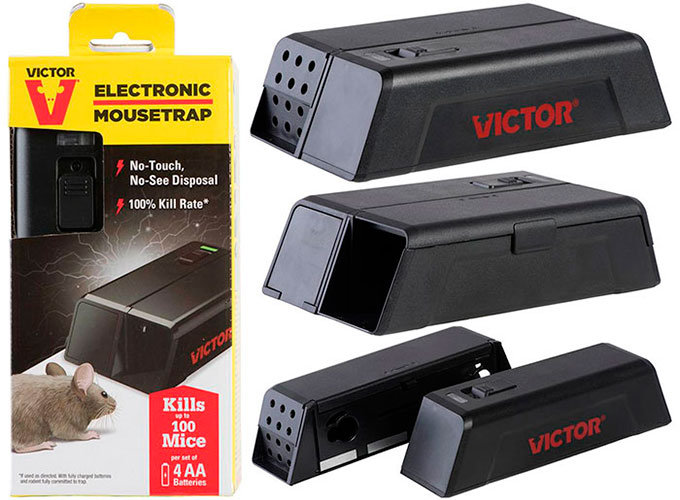
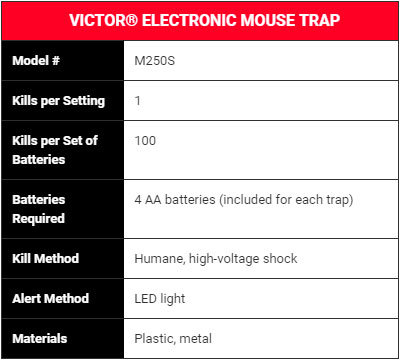
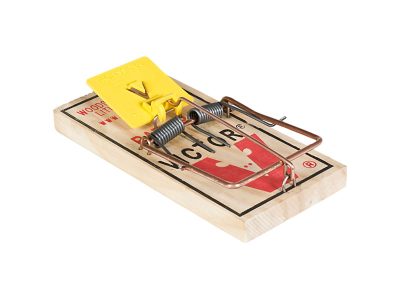
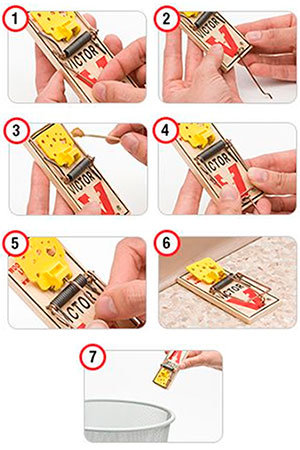 Remove the clip that secures the kill bar to the rest of the trip. The clip should be easy to locate when looking at the top part of the trap with the Victor logo.
Remove the clip that secures the kill bar to the rest of the trip. The clip should be easy to locate when looking at the top part of the trap with the Victor logo.